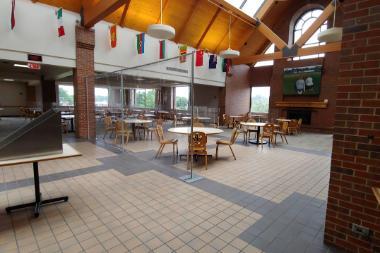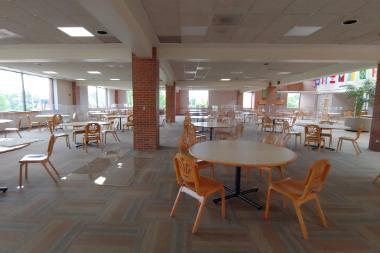August 13, 2020
Wheaton College Auxiliary Services Director Tony Dawson gives us a sneak peek into the planning for dining at Wheaton during the fall 2020 semester.
 How do you feed 1,700 Wheaton College students three times a day while keeping them socially distanced at all times?
How do you feed 1,700 Wheaton College students three times a day while keeping them socially distanced at all times?
That was the challenge facing Wheaton College Auxiliary Services Director Tony Dawson and Bon Appetit General Manager Raul Delgado this fall. After receiving guidelines from the Centers for Disease Control and the Illinois Department of Public Health, the team had just three months until students started arriving back on campus to come up with a plan. And it really was a team effort.
"Many people from across campus worked hard to develop and implement this plan," Dawson said. "Facilities Management, Facilities Development, Carpentry, Bon Appetit, Event Services, and other departments all contributed to this effort."
Step One: Consult the Experts
One of their first steps was contracting with an industrial hygienist (someone who specializes in protecting and mitigating safety in the use of materials and systems) who gave them guidance on how to comply with regulations, such as limiting students to 50 or fewer per room. They worked to create large plastic barriers now hanging in Anderson Commons and splitting the dining hall into eight distinct spaces upstairs and six spaces downstairs for a total of approximately 600 seats. They also added plexiglass separators on the tables that will act as protective barriers while students are eating. Outside of the Beamer Center, students can also bring their meals back to their residence halls, to the classroom, or to one of the six outdoor tents erected around campus.
Step Two: Reroute Traffic Flow
But how to actually get students into the building? Normally, the dining hall would be flooded with students—especially during lunchtimes after Chapel services or days when Bon Appetit’s famous chicken tenders and fries were on the menu. To get students fed while keeping them socially distanced, Dawson, Delgado, and the team came up with a new traffic flow that would keep students six feet apart as they are lined up to get inside. To protect students from any inclement weather, they also erected large tents next to Coray Gym that students will queue under.
Uniformed greeters will also be posted at certain intervals to keep lines moving, help students find available seating, and remind students about the new protocols.
 Step Three: Rethink the Routines
Step Three: Rethink the Routines
Other changes have been added as well. Whereas mealtimes used to be two hours long, they’re now going to be extended to three hours-plus. Before the pandemic, students could pile their own plates at several different food stations; now, they’re going to be served in to-go containers. But it’s important to note that students will be able to designate how much food they want.
"If they’re really hungry or are big eaters, they can say, 'Hey, I need more.' So even though the food is being served to them, we don’t want anyone to leave hungry," Dawson said.
Even as new changes are implemented, there are some things that are staying constant--the same high-quality Bon Appetit food, for instance. Also, students that have food allergies or sensitivities will still find options at every meal they can eat.
"We take that very seriously and will not compromise in that area," Dawson said.
Step Four: Tackle Lunchtime Logistics
Even with all of this planning, considering the logistics around serving lunch was proving particularly problematic. All but about 200 students had classes scheduled across the lunch hours.
"If students tried to enter the lunch lines whenever they wanted, they wouldn’t get through in time to be able to eat and get to class, given all of the COVID-related precautions we’re taking," Dawson said.
With that in mind, Dawson, Delgado and the team devised a system of individual lunchtimes. Each student will be given a specific lunchtime coordinated with their class schedule that will enable them to get through the lunch line and eat in time for them to make it to class.
They can also swipe twice at breakfast, allowing them to get breakfast and also pick up a pack lunch that they can eat at their leisure. Finally, grab-and-go meals will also be offered daily from 2-4 p.m.
"It’s been quite an undertaking," Dawson said. "But we’re grateful that God helped us come up with a plan that we hope will serve our students in a COVID-Safe, Thunder Strong way." —Emily Bratcher